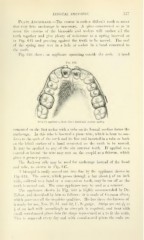Page 719 - My FlipBook
P. 719
LINGUAL ERUPTION. Ill
Pi.ATE AxcHOEAGE.—The Canine is such a difficult tooth to move
that very firm anchorage is necessary. A plate constructed so as to
cover the crowns of the bicuspids and molars will anchor all the
teeth together and give plenty of resistance to a spring inserted as
in Fig. 645 and pressing against the tooth to be moved. The end
of the spring may rest in a hole or socket in a band cemented to
the tooth.
Fig. 646 shows an appliance operating outside the arch. A baud
Fig. 646.
Writer's appliance, close bite : band and outside spring.
cemented on the first molar with a tube on its buccal surface forms the
anchorage. In this tube is inserted a piano wire, which is bent to con-
form to the arch of the teeth and its free end inserted in a tube or hook
on the labial surface of a band cemented on the tooth to be moved.
It may be applied to any of the six anterior teeth. If applied to a
central or lateral the wire may rest on the cuspid as a fulcrum, which
gives it greater power.
The Jack.S(m crib may be used for anchorage instead of the band
and tube, as shown in Fig. 647.
A bicuspid is easily moved out into line by the appliance shown in
Fig. 648. The screw, which passes through a bar about \ of an inch
wide, soldered to a band on a convenient tooth, may be cut off as the
tooth is moved out. The same appliance may be used as a retainer.
The ap]>liance shown in Fig. 649 is highly recommended by Dr.
Talbot, and described by him as follows : It is made of German silver,
which possesses all the requisite (jualities. He has three thicknesses of
it ready for use, Xos. 29, 31, and 32, U. S. gauge. Strips are cut Jg to
X of an inch wide accordingly as strength is required, and bent with
small round-nosed pliers into the shape represented at a to fit the teeth.
This is removed every day and with round-nosed pliers the ends are


